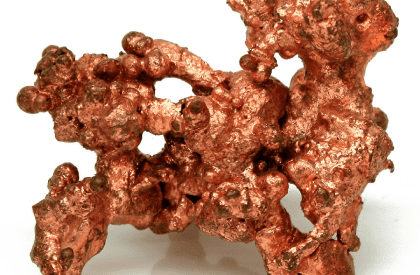Copper
-
Carbon
Carbon
-
Copper
Copper
-
Tantalum
Tantalum
-
Coltan
Coltan
-
Magnetite Iron
Magnetite Iron
-
Manganese
Manganese
-
Graphite
Graphite
Our Brochures
Contact Us
Social Media


It is a soft, malleable, and ductile metal with very high thermal and electrical conductivity. Copper is used as a conductor of heat and electricity, as a building material, and as a constituent of various metal alloys, such as sterling silver used in jewelry, cupronickel used to make marine hardware and coins, and constantan used in strain gauges and thermocouples for temperature measurement.
General Characteristics
Unlike metals with incomplete d-shells, metallic bonds in copper are lacking a covalent character and are relatively weak. This observation explains the low hardness and high ductility of single crystals of copper. The softness of copper partly explains its high electrical conductivity (59.6×106 S/m) and high thermal conductivity, second highest (second only to silver) among pure metals at room temperature. This is because the resistivity to electron transport in metals at room temperature originates primarily from scattering of electrons on thermal vibrations of the lattice, which are relatively weak in a soft metal.
Copper is one of a few metallic elements with a natural color other than gray or silver. Pure copper is orange-red and acquires a reddish tarnish when exposed to air. This is due to the low plasma frequency of the metal, which lies in the red part of the visible spectrum, causing it to absorb the higher-frequency green and blue colors.
Copper ALLOYSChemical CompositionNumerous copper alloys have been formulated, many with important uses. Brass is an alloy of copper and zinc. Bronze usually refers to copper-tin alloys, but can refer to any alloy of copper such as aluminium bronze. Copper is one of the most important constituents of silver and karat gold solders used in the jewelry industry, modifying the color, hardness and melting point of the resulting alloys.
Non-magnetic material with high ductility, electrical and thermal conductivity and fatigue resistance.
Reasonable mechanical mechanical properties, with low friction coefficient, good resistance to impact, corrosion and ease of welding. Basic use in the electrical industry.
%Cu
%Sn
%Pb
%Zn
%Fe
Rem.
4,2 – 5,8
0,05 max.
0,3 max.
0,1 max.
Mechanical and Physical Properties
Factor
Tensile Strength, Kg/mm2
Yield Point, Kg/mm2
Elongation, %
Typical Hardness, HB (10mm/500kg)
Thermal Conductivity, BTU.Ft / (hr.Ft².°F) a 68 °F
Coefficient Of Thermal Expansion, 10-6 pulg/pulg/°F (68 – 572 °F)
Electrical Conductivity, % IACS a 68 °F
Maximum Operating Temperature, °C
Maximum Operating Pressure, Kg/mm2
Quantity
32,3
13,3
14
66
40
9,9
15
280
–
